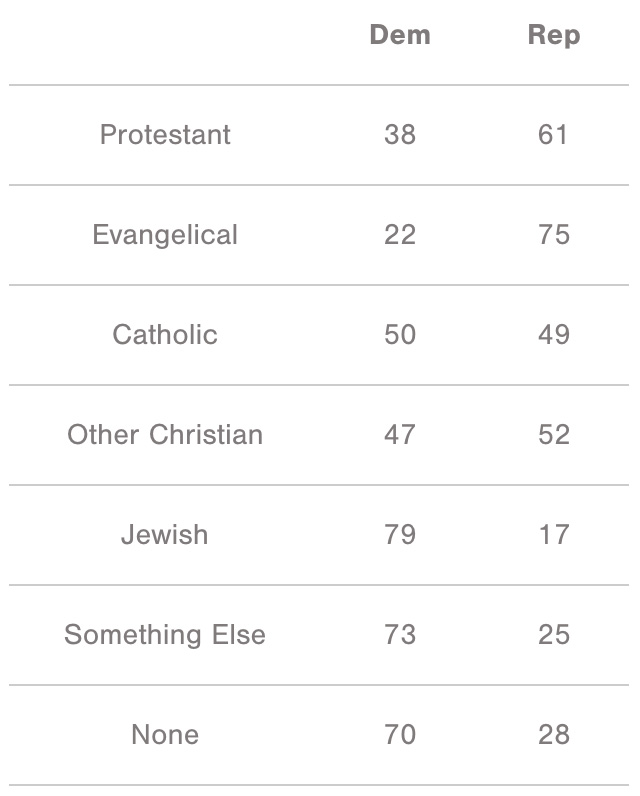It’s always dangerous to read too much into post-election exit polls, which often turn out to be incomplete or off the mark. But when has that ever stopped a dedicated pundit?
Therefore, feast your eyes on data, in this case how various religious groups voted in U.S. House races:

NBC’s exit polls didn’t collect enough responses from Muslims to report data, and the Protestant, evangelical and Other Christian categories surely overlap to some extent.
The Pew Research team says these numbers are all in line with other midterm elections, but that’s a bit misleading, because the turnout this year was so much larger than in recent midterms. All told, 30 million fewer voters showed up at the polls in 2014 than this year. In 2010, Obama’s first midterms and the year of the Tea Party wave, about 23 million fewer came out. That’s about the same distance between 2018 and 2016.
In other words, the structure of this year’s electorate resembles a presidential cycle as much as a midterm. So it might be helpful (if not demographically correct) to compare 2018 both to previous midterms and to its immediate predecessor in 2016.
And indeed, an interesting story emerges. In 2016, 81 percent of evangelical voters famously supported President Trump, but this year, he’s down to 75 percent. Does that mean his base is shriveling up? Probably not. As Pew says, because these numbers are roughly in line with other elections, it most likely means evangelicals are reverting to mean. Trump’s yuge win with them in 2016 may turn out to have been not much more than a blip on the screen. At the same time, even though evangelical support for Republicans declined somewhat between 2014 and 2018, in terms of raw numbers, many more evangelicals voted this year. That might explain why Republicans were able to hold on to seats in the South and eke out narrow victories in Florida.
Likewise, about 70 percent of Jews voted Democratic in 2016, but 79 percent did so this year. Once again, that’s on a par with previous midterm elections, which indicates that some Jews may have flirted with Trump, but now are returning to established patterns.
Perhaps the most interesting shifts were among groups seldom considered in all the focus on evangelicals. Voters who were affiliated with smaller religions came out for Clinton 62-29, a steep drop from their previous Democratic support. Yet here they snap back to pattern, hard. (Interestingly, the last time their support for Dems dipped so sharply was with Al Gore, the other candidate of the 20th century to win the popular vote and lose the Electoral College.)
Same with the religiously unaffiliated: After falling from a high of 75 percent for Obama in 2008, the “nones” dropped down to 68 percent for Hillary Clinton, but now they’re inching back towards the Democrats, 70-28. But notice what’s been happening with their share of the electorate: In 2006, religiously unaffiliated voters were 11 percent of total voters. In 2014, it was 12 percent. This year, it’s 17 percent. Over the same period, percentages of white evangelical voters have remained relatively stable between 24 percent and 26 percent. Protestants are no longer the majority of the electorate, for the first time in American history.
No doubt this year’s increase in the unaffiliated vote overlaps with a jump in youth participation, but that only makes it the worse for conservatives and the GOP. Again, it’s dangerous to read too much into exit polls and demographics, but the future looks increasingly secular—and blue.

